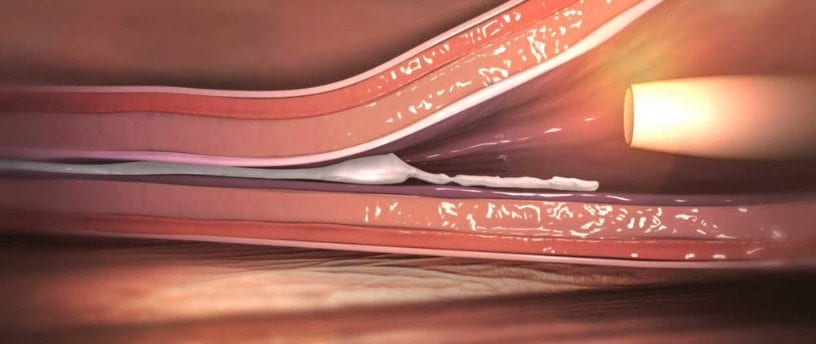Canada Vein Clinics is known for providing new technology and state-of-the-art treatments since our inception 15 years ago. The VenaSeal Closure System was approved by Health Canada in 2014, and our expert physicians have been at the forefront of performing this advanced procedure ever since that time.
Our team of skilled CVC physicians are at the height of compassionate patient care and conducting safe, effective vein procedures. Our patients are presented with custom-tailored treatment plans that will help to remove the pain and discomfort of varicose and spider veins while achieving the best results. No longer are these vein conditions seen as cosmetic; they are treated as the beginnings of potentially serious medical conditions.
What is VenaSeal?
 VenaSeal is a fairly new procedure, approved by the FDA in the United States, Health Canada, and in use throughout Europe. The VenaSeal Closure System is used to target the great saphenous vein and any superficial veins that are affected by insufficiency. VenaSeal was developed in the United States by a company called Sapheon, creating a medical “superglue” to help close off these veins. Instead of treating the saphenous vein with laser or Sclerotherapy, this VenaSeal acts as an adhesive inserted into the lumen of the vein.
VenaSeal is a fairly new procedure, approved by the FDA in the United States, Health Canada, and in use throughout Europe. The VenaSeal Closure System is used to target the great saphenous vein and any superficial veins that are affected by insufficiency. VenaSeal was developed in the United States by a company called Sapheon, creating a medical “superglue” to help close off these veins. Instead of treating the saphenous vein with laser or Sclerotherapy, this VenaSeal acts as an adhesive inserted into the lumen of the vein.
Why target the saphenous vein?
The great saphenous vein is the major vein in the leg, located nearest the inner thigh. This large vein runs from the foot all the way up to the groin, and helps to push blood back up to the heart from the surface veins of the lower leg. This vein can become stretched as valve function fails to perform properly and can be the cause of many of the varicose veins we see on the surface of the skin. VenaSeal targets the saphenous vein and its branches (saphenofemoral junction) as it is the main point of blood flow.
What is the VenaSeal superglue made of?
The VenaSeal super glue is made of a substance referred to as cyanoacrylate – a clear, free-flowing liquid. The superglue is sterile and safe for insertion into the vein. Cyanoacrylate has been used for years within the medical community as a strong adhesive and is a trusted substance that does no harm to the body.
How is VenaSeal performed?
Before performing VenaSeal, your Canada Vein Clinics physician will perform an ultrasound to superimpose a picture of the vein on a monitor for reference during the procedure. This procedure is minimally invasive, and the use of ultrasound helps to avoid surgical exploration of the vein; the ultrasound is painless and has no side effects. Once the physician has a clear view of the saphenous vein through the ultrasound map, the procedure is ready to begin.
VenaSeal is an outpatient procedure and only requires the use of a topical anesthetic for the initial needle insertion to direct the small catheter into the saphenous vein. The physician enters the saphenous vein through a point behind the knee called the saphenopopliteal junction. The guidewire provided in the VenaSeal kit is used to aid with ultrasound imaging so that the physician can see the progress and position of the catheter within the vein. Once the catheter is in position with the assistance of the guidewire, the dilator is inserted to create space for the introducer. This introducer is placed into the vein as a flush system for a saline solution. Saline is simply a saltwater solution that helps to prep the vein for the cyanoacrylate super glue and causes no damage to the vein.
Inserting the VenaSeal Adhesive
Your CVC physician and assisting nurse load the VenaSeal dispenser gun with the VenaSeal superglue solution, and precisely calculated amounts of the adhesive are inserted into the highest point of the saphenous vein via the catheter. As the glue is inserted into the lumen of the vein, the physician will apply pressure to the area helping the VenaSeal glue to polymerize (harden) and block off blood flow. Every few seconds, the physician will pull back the catheter about 3 cm, and dispense more of the VenaSeal superglue down the vein.
Once the glue is applied throughout the vein, the physician will remove the catheter from the leg and continue to apply pressure to the area. Depending on the length of the affected vein treated, this procedure can take up to an hour or more to complete. Your CVC physician will tell you an approximate time for completion of the procedure.
Results of VenaSeal Treatment
VenaSeal will close the affected vein permanently and eliminate the appearance of varicose veins from the legs over time. Your physician will discuss results with you before the procedure. VenaSeal is proven to be 98.9% effective in medical studies across the board.
The use of VenaSeal is a preferred solution to block the saphenous vein, without complete removal. The saphenous vein can be used in bypass surgery in the future, should you require it. This procedure will take care of the appearance of varicose veins while keeping this important vein intact.
Contact Canada Vein Clinics today and schedule your consultation and ultrasound exam. Our vein experts are ready to help you achieve healthy, gorgeous legs.

